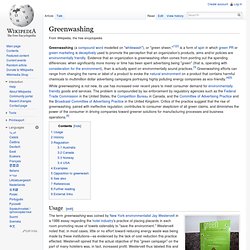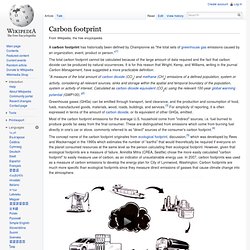

DEKRA - Information zum Thema CO2. EN - Reduction. EN - Reporting and Progress. Energy Cities. Organizations. Green Marketing: How To Reduce Your Carbon & Hype Footprints. Global Warming, Climate Change, Ecosystems, Sustainable Markets, Good Governance & the Environment. Global-warming potential. Global-warming potential (GWP) is a relative measure of how much heat a greenhouse gas traps in the atmosphere. It compares the amount of heat trapped by a certain mass of the gas in question to the amount of heat trapped by a similar mass of carbon dioxide.
A GWP is calculated over a specific time interval, commonly 20, 100 or 500 years. GWP is expressed as a factor of carbon dioxide (whose GWP is standardized to 1). For example, the 20 year GWP of methane is 86, which means that if the same mass of methane and carbon dioxide were introduced into the atmosphere, that methane will trap 86 times more heat than the carbon dioxide over the next 20 years.[1] The substances subject to restrictions under the Kyoto protocol either are rapidly increasing their concentrations in Earth's atmosphere or have a large GWP.
Greenwashing. While greenwashing is not new, its use has increased over recent years to meet consumer demand for environmentally friendly goods and services.

The problem is compounded by lax enforcement by regulatory agencies such as the Federal Trade Commission in the United States, the Competition Bureau in Canada, and the Committee of Advertising Practice and the Broadcast Committee of Advertising Practice in the United Kingdom. Critics of the practice suggest that the rise of greenwashing, paired with ineffective regulation, contributes to consumer skepticism of all green claims, and diminishes the power of the consumer in driving companies toward greener solutions for manufacturing processes and business operations.[6] Usage[edit] Hotel "greenwashed" laundry card. Carbon shifting. Carbon shifting is the tendency for an individual to increase carbon dioxide emissions in one area of their lifestyle as a result of reducing emissions elsewhere.
‘Carbon shifting’ might more accurately be termed ‘domestic carbon shifting’ to distinguish it from carbon leakage which has occasionally also been called carbon shifting.[1] Many attempts to encourage people to change aspects of their lifestyle and so reduce their carbon dioxide emissions make a virtue of the financial savings. In the United Kingdom the Energy Saving Trust lists various ways of saving energy, e.g. “Energy saving light bulbs last up to 12 times longer than ordinary lightbulbs and can save you £9 per year in electricity (and 38 kilograms of CO2) or £100 over the bulbs lifetime.” [2] However, whether or not carbon dioxide emissions are ultimately reduced will depend on how that saved money is spent. See also[edit] Notes[edit] Carbon leakage. Carbon leakage occurs when there is an increase in carbon dioxide emissions in one country as a result of an emissions reduction by a second country with a strict climate policy.
Carbon leakage may occur for a number of reasons: if the emissions policy of a country raises local costs, then another country with a more relaxed policy may have a trading advantage. If demand for these goods remains the same, production may move offshore to the cheaper country with lower standards, and global emissions will not be reduced.if environmental policies in one country add a premium to certain fuels or commodities, then the demand may decline and their price may fall. Countries that do not place a premium on those items may then take up the demand and use the same supply, negating any benefit.
There is no consensus over the magnitude of long-term leakage effects.[1] This is important for the problem of climate change, which covers long time periods. Coal, oil and "backstop" technologies[edit]
Water footprint and virtual water. Many nations save domestic water resources by importing water-intensive products and exporting commodities that are less water intensive. National water saving through the import of a product can imply saving water at a global level if the flow is from sites with relatively high water productivity (i.e. commodities with a small water footprint) to sites with low water productivity (commodities with a large water footprint).
The total amount of water that would have been required in the importing countries if all imported agricultural products would have been produced domestically is 2407 billion m3/yr. These products are however being produced with only 2038 billion m3/yr in the exporting countries, saving global water resources by 369 billion m3/yr (Mekonnen and Hoekstra, 2011). Water footprint and virtual water. There is a relation between consumption by Dutch consumers and impacts on water systems elsewhere in the world. Many of the goods consumed in the Netherlands are not produced in the Netherlands, but abroad. Some of these goods, in particular agriculture-based products, require a lot of water during production. These water-intensive production processes are accompanied by impacts on the water systems at the various locations where the production processes take place. The total water footprint of the Netherlands is estimated to be about 2300 m3/yr/cap, of which 67% relates to the consumption of agricultural goods, 31% to the consumption of industrial goods, and 2% to domestic water use.
Water footprint. Water use can mean the amount of water used by a household or a country, or the amount used for a given task or for the production of a given quantity of some product or crop. The term "water footprint" is often used to refer to the amount of water used by an individual, community, business, or nation. World water use has been growing rapidly in the last hundred years (see graph from New Scientist article[1]). From 1900 to 2000, water use for agriculture went from about 500 to 2,500 cubic kilometers per year, while total use rose from around 600 to more than 3,000 cubic kilometres per year. Water footprint and virtual water. International trade in food and other products implies international flows of virtual water. Carbon Footprint - Registration. Water footprint and virtual water. Water footprint and virtual water. HOME - Ecological Footprint - Ecological Sustainability.
Footprint for Cities. Why track resource consumption and natural capital? Local governments succeed by helping all their residents live fulfilling lives, both today and in the future. The availability of natural capital, nature’s ability to renew and provide resources and services, is not the only ingredient in this vision. However, without natural capital – healthy food, energy for mobility and heat, fibre for paper, clothing and shelter, fresh air and clean water – such a vision is impossible. Thus, providing current and future human well-being depends on protecting natural capital from systematic overuse; otherwise, nature will no longer be able to secure society with these basic services.
What’s in it for local governments? Ecological Footprint accounts allow governments to track a city or region’s demand on natural capital, and to compare this demand with the amount of natural capital actually available. San Francisco, CA (USA) Footprint for Finance. The international debt crisis that has roiled world markets in recent years has challenged long-held assumptions of how to best measure a country’s wealth and gage its economic stability. Monitoring social and economic variables alone, a growing number of investors now understand, is no longer enough to understand nations’ competitiveness. In a resource-constrained world, a critical component of economic success will be through careful biocapacity management. But until now there has been no methodology that enables credit rating agencies, investors and financial information providers to integrate such ecological data in their respective risk models.
In October 2011, Global Footprint Network launched a two-year project with the United Nations Environment Programme Finance Initiative (UNEP FI) and leading financial institutions to investigate the links between ecological and financial risks at the country level, and introduce more ecologically informed risk analysis into the market. Free Carbon Footprint Calculator. Carbon footprint. A carbon footprint has historically been defined by Championne as "the total sets of greenhouse gas emissions caused by an organization, event, product or person.

"[1] The total carbon footprint cannot be calculated because of the large amount of data required and the fact that carbon dioxide can be produced by natural occurrences. It is for this reason that Wright, Kemp, and Williams, writing in the journal Carbon Management, have suggested a more practicable definition: "A measure of the total amount of carbon dioxide (CO2) and methane (CH4) emissions of a defined population, system or activity, considering all relevant sources, sinks and storage within the spatial and temporal boundary of the population, system or activity of interest. Most of the carbon footprint emissions for the average U.S. household come from "indirect" sources, i.e. fuel burned to produce goods far away from the final consumer.
Carbon Footprint - Small and Medium Sized Businesses. Carbon Footprint - Home of Carbon Management.